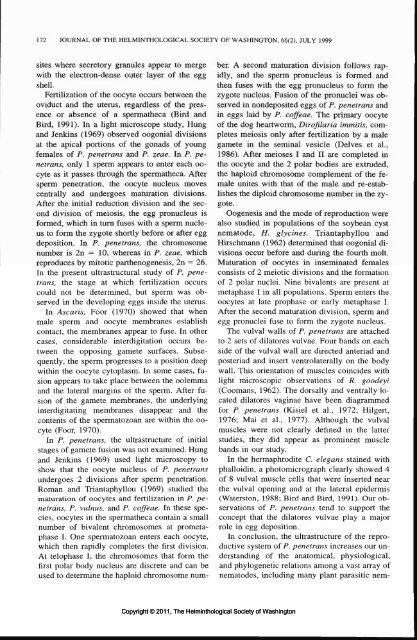The Helminthological Society of Washington - Peru State College
The Helminthological Society of Washington - Peru State College
The Helminthological Society of Washington - Peru State College
Create successful ePaper yourself
Turn your PDF publications into a flip-book with our unique Google optimized e-Paper software.
172 JOURNAL OF THE HELMINTHOLOGICAL SOCIETY OF WASHINGTON, 66(2), JULY 1999<br />
sites where secretory granules appear to merge<br />
with the electron-dense outer layer <strong>of</strong> the egg<br />
shell.<br />
Fertilization <strong>of</strong> the oocyte occurs between the<br />
oviduct and the uterus, regardless <strong>of</strong> the presence<br />
or absence <strong>of</strong> a spermatheca (Bird and<br />
Bird, 1991). In a light microscope study, Hung<br />
and Jenkins (1969) observed oogonial divisions<br />
at the apical portions <strong>of</strong> the gonads <strong>of</strong> young<br />
females <strong>of</strong> P. penetrans and P. zeae. In P. penetrans,<br />
only 1 sperm appears to enter each oocyte<br />
as it passes through the spermatheca. After<br />
sperm penetration, the oocyte nucleus moves<br />
centrally and undergoes maturation divisions.<br />
After the initial reduction division and the second<br />
division <strong>of</strong> meiosis, the egg pronucleus is<br />
formed, which in turn fuses with a sperm nucleus<br />
to form the zygote shortly before or after egg<br />
deposition. In P. penetrans, the chromosome<br />
number is 2n = 10, whereas in P. zeae, which<br />
reproduces by mitotic parthenogenesis, 2n = 26.<br />
In the present ultrastructural study <strong>of</strong> P. penetrans,<br />
the stage at which fertilization occurs<br />
could not be determined, but sperm was observed<br />
in the developing eggs inside the uterus.<br />
In Ascaris, Poor (1970) showed that when<br />
male sperm and oocyte membranes establish<br />
contact, the membranes appear to fuse. In other<br />
cases, considerable interdigitation occurs between<br />
the opposing gamete surfaces. Subsequently,<br />
the sperm progresses to a position deep<br />
within the oocyte cytoplasm. In some cases, fusion<br />
appears to take place between the oolemma<br />
and the lateral margins <strong>of</strong> the sperm. After fusion<br />
<strong>of</strong> the gamete membranes, the underlying<br />
interdigitating membranes disappear and the<br />
contents <strong>of</strong> the spermatozoan are within the oocyte<br />
(Poor, 1970).<br />
In P. penetrans, the ultrastructure <strong>of</strong> initial<br />
stages <strong>of</strong> gamete fusion was not examined. Hung<br />
and Jenkins (1969) used light microscopy to<br />
show that the oocyte nucleus <strong>of</strong> P. penetrans<br />
undergoes 2 divisions after sperm penetration.<br />
Roman and Triantaphyllou (1969) studied the<br />
maturation <strong>of</strong> oocytes and fertilization in P. penetrans,<br />
P. vulnus, and P. c<strong>of</strong>feae. In these species,<br />
oocytes in the spermatheca contain a small<br />
number <strong>of</strong> bivalent chromosomes at prometaphase<br />
I. One spermatozoan enters each oocyte,<br />
which then rapidly completes the first division.<br />
At telophase I, the chromosomes that form the<br />
first polar body nucleus are discrete and can be<br />
used to determine the haploid chromosome number.<br />
A second maturation division follows rapidly,<br />
and the sperm pronucleus is formed and<br />
then fuses with the egg pronucleus to form the<br />
zygote nucleus. Fusion <strong>of</strong> the pronuclei was observed<br />
in nondeposited eggs <strong>of</strong> P. penetrans and<br />
in eggs laid by P. c<strong>of</strong>feae. <strong>The</strong> primary oocyte<br />
<strong>of</strong> the dog heartworm, Dir<strong>of</strong>ilaria immitis, completes<br />
meiosis only after fertilization by a male<br />
gamete in the seminal vesicle (Delves et al.,<br />
1986). After meioses I and II are completed in<br />
the oocyte and the 2 polar bodies are extruded,<br />
the haploid chromosome complement <strong>of</strong> the female<br />
unites with that <strong>of</strong> the male and re-establishes<br />
the diploid chromosome number in the zygote.<br />
Oogenesis and the mode <strong>of</strong> reproduction were<br />
also studied in populations <strong>of</strong> the soybean cyst<br />
nematode, H. glycines. Triantaphyllou and<br />
Hirschmann (1962) determined that oogonial divisions<br />
occur before and during the fourth molt.<br />
Maturation <strong>of</strong> oocytes in inseminated females<br />
consists <strong>of</strong> 2 meiotic divisions and the formation<br />
<strong>of</strong> 2 polar nuclei. Nine bivalents are present at<br />
metaphase I in all populations. Sperm enters the<br />
oocytes at late prophase or early metaphase I.<br />
After the second maturation division, sperm and<br />
egg pronuclei fuse to form the zygote nucleus.<br />
<strong>The</strong> vulval walls <strong>of</strong> P. penetrans are attached<br />
to 2 sets <strong>of</strong> dilatores vulvae. Four bands on each<br />
side <strong>of</strong> the vulval wall are directed anteriad and<br />
posteriad and insert ventrolaterally on the body<br />
wall. This orientation <strong>of</strong> muscles coincides with<br />
light microscopic observations <strong>of</strong> R. goodeyi<br />
(Coomans, 1962). <strong>The</strong> dorsally and ventrally located<br />
dilatores vaginae have been diagrammed<br />
for P. penetrans (Kisiel et al., 1972; Hilgert,<br />
1976; Mai et al., 1977). Although the vulval<br />
muscles were not clearly defined in the latter<br />
studies, they did appear as prominent muscle<br />
bands in our study.<br />
In the hermaphrodite C. elegans stained with<br />
phalloidin, a photomicrograph clearly showed 4<br />
<strong>of</strong> 8 vulval muscle cells that were inserted near<br />
the vulval opening and at the lateral epidermis<br />
(Waterston, 1988; Bird and Bird, 1991). Our observations<br />
<strong>of</strong> P. penetrans tend to support the<br />
concept that the dilatores vulvae play a major<br />
role in egg deposition.<br />
In conclusion, the ultrastructure <strong>of</strong> the reproductive<br />
system <strong>of</strong> P. penetrans increases our understanding<br />
<strong>of</strong> the anatomical, physiological,<br />
and phylogenetic relations among a vast array <strong>of</strong><br />
nematodes, including many plant parasitic nem-<br />
Copyright © 2011, <strong>The</strong> <strong>Helminthological</strong> <strong>Society</strong> <strong>of</strong> <strong>Washington</strong>
















